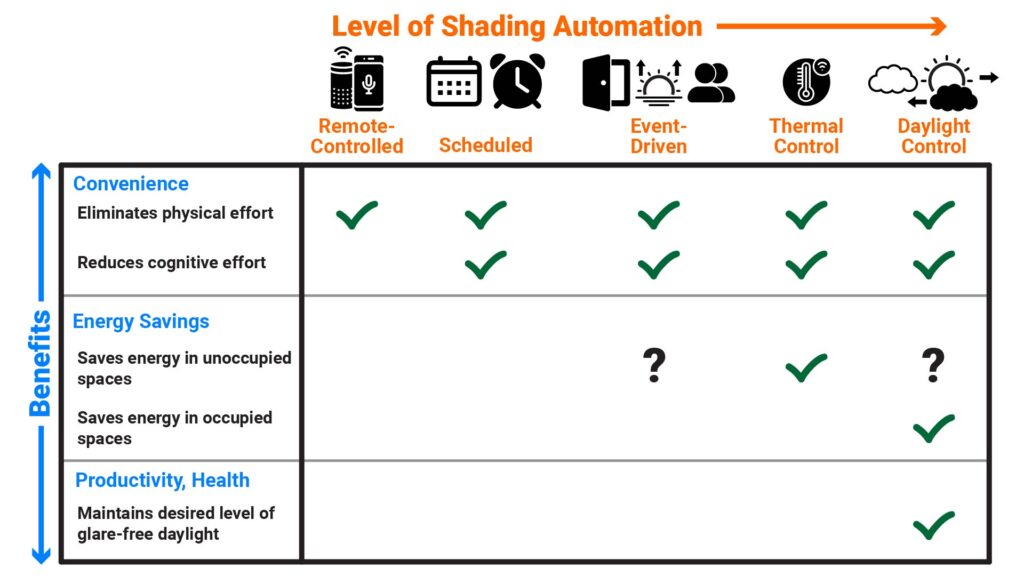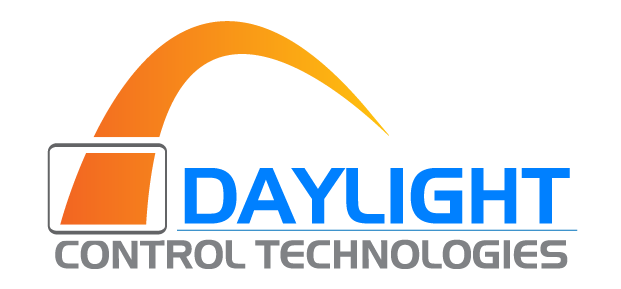The 5 Levels of Shading Automation
Smart shading products and systems don’t just differ in the type of shading device they use, but also in how “smart” they are. There are five levels of shading automation, each providing different benefits:

Remote-Controlled Operation
Virtually all automated shading products can be remote-controlled by a wireless remote, app, or voice assistant. This lowest level of automation eliminates the physical effort associated with shading adjustments, and is particularly useful for hard-to-reach window coverings or when more than one window covering needs to be adjusted simultaneously. However, while obviously useful, remote control isn’t really automation because it still requires deliberate action from the user.
The lowest levels of true automation are scheduled automation and event-driven automation.
Scheduled Automation
Scheduled automation enables a user to pre-set a schedule of automatic shading adjustments based on time of day and day of week. While this can be useful in some situations, most peoples’ shading preferences don’t vary according a rigid timetable. For that reason—and because some thought and effort is required to set up a shading schedule that makes sense—scheduled automation isn’t actually used very often even when it’s available.
Event-Driven Automation
Event-driven automation enables a user to define a set of rules that trigger shading adjustments based on events such as sunrise/sunset, room occupancy, and presence of direct sunlight. The rules can include the time of day and the day of the week as criteria for shading adjustments, so event-driven automation subsumes scheduled automation.
Event-driven automation is potentially far more useful than scheduled automation alone, because peoples’ shading preferences are much more closely correlated to events than to schedules. However, the actual usefulness of event-driven automation depends on the type and number of events considered, which in turn drives the need for integration with remote sensors as well as the time and effort needed to set-up and refine the automation rules.
Most event-driven automated shading systems consider temperature or light only as discrete variables, such as daytime versus nighttime or direct sunlight versus no direct sunlight. However, some automated shading systems do consider temperature and light as analog (gradually varying) variables, and this brings us to the next two levels of shading automation.
Responsive Thermal Control
Window coverings can modulate the solar and thermal heat transfer through a window, so shading automation opens up the possibility of reducing HVAC energy consumption. That’s the purpose of responsive thermal control: it automatically adjusts the shading to minimize the window’s contribution to the thermal loads on the HVAC system.
Because shading settings optimized to minimize HVAC consumption will often conflict with the occupants’ preferred shading settings, responsive thermal control is typically done only in unoccupied spaces (or at nighttime).
Responsive thermal control could be implemented by adding rules to an event-driven system, such as to open the shading in winter daytime and summer nighttime, and to close the shading in summer daytime and winter nighttime.
However, such a simple rules-driven algorithm can actually increase energy consumption in certain climates and seasons. Achieving reliable year-round energy savings requires that the shading adjustments be based on the actual dominant HVAC load at the time (i.e. either heating or cooling) and the actual external temperature and/or weather forecast.
This, in turn, typically requires that the shading system receive information from both the HVAC system (or a smart thermostat) and a source of weather information. This kind of integration is fairly common among professionally installed automated shading systems (especially in commercial buildings), but not yet in direct-to-consumer smart shading devices. However, the emergence of the Matter networking standard should facilitate more widespread use of responsive thermal control in the hopefully (near) future.
Responsive Daylight Control
Responsive daylight control involves automatically adjusting the shading to maintain a desired level of admitted daylight. This is the most sophisticated and valuable level of automated shading, but also the most challenging to implement.
Responsive daylight control wouldn’t be very valuable if people periodically adjusted manually operated window coverings throughout the day. However, that’s definitely not the case: people typically adjust manually operated window coverings less than once per day, and instead usually leave them in a mostly-closed position.
This means that windows are usually admitting less glare-free daylight—sometimes more solar heat—than they would if the shading were always optimally adjusted. That’s the problem solved by responsive daylight control:
- It increases the average level of glare-free daylight, providing a more appealing and ergonomic visual environment while reducing the need for artificial lighting.
- It reduces solar heat gains under peak-irradiance conditions, reducing cooling loads on the HVAC system.
The benefits are so compelling that the U.S. government has sponsored research and development of responsive daylight control technologies since the first energy crises of the 1970’s.
However, while the concept is simple, actually implementing a cost-effective and occupant-friendly responsive daylight control system is extremely challenging, for at least three reasons:
- The shading device must be capable of gradually varying the amount of admitted daylight while operating as unobtrusively as possible. Only motorized venetian blinds and relatively expensive Smart Windows meet these requirements.
- The system must regulate the admitted daylight level as perceived by room occupants, especially under conditions that could cause glare. This is a major challenge with conventional sensor technology and especially with venetian blinds.
- If a motorized blind is used instead of a Smart Window, the system must balance responsiveness to changing daylight levels against excessively frequent adjustments which would annoy the occupants and wear-out the motor.
Because responsive daylight control is much easier with a Smart Window than a motorized blind, the U.S. Department of Energy has funded Smart Window R&D for decades, and the Inflation Reduction Act of 2022 includes substantial tax incentives for use of Smart Windows. However, Smart Window technology is still too expensive for mainstream use and seems likely to remain so for the foreseeable future—and motorized blinds will always be far more cost-effective than Smart Windows for responsive daylight control.
On the other hand, meeting the above-listed requirements with a motorized venetian blind has proven so elusive that—despite having been demonstrated by government-sponsored researchers more than three decades ago—blind-based responsive daylight control still has virtually negligible usage in the U.S.
